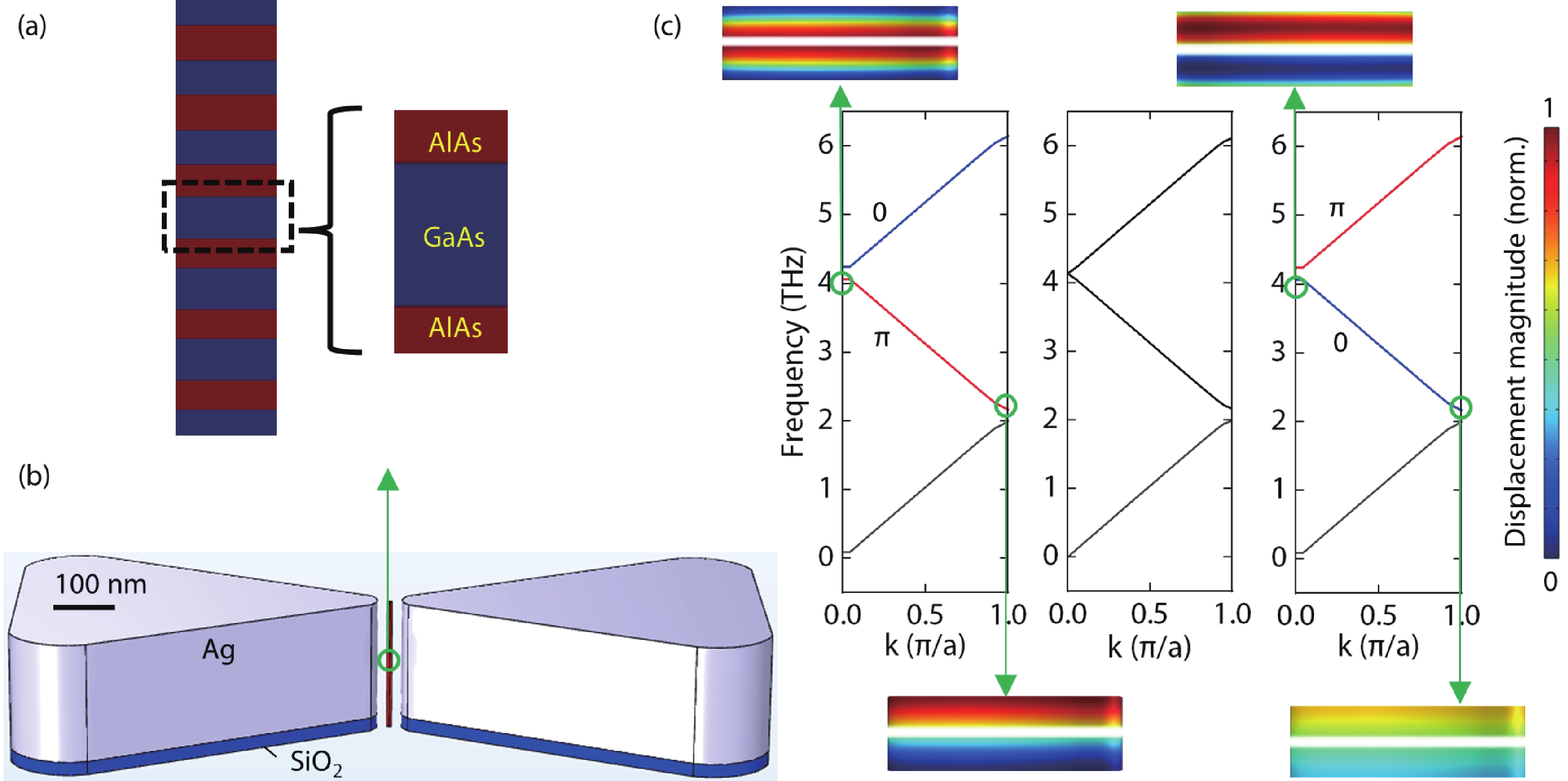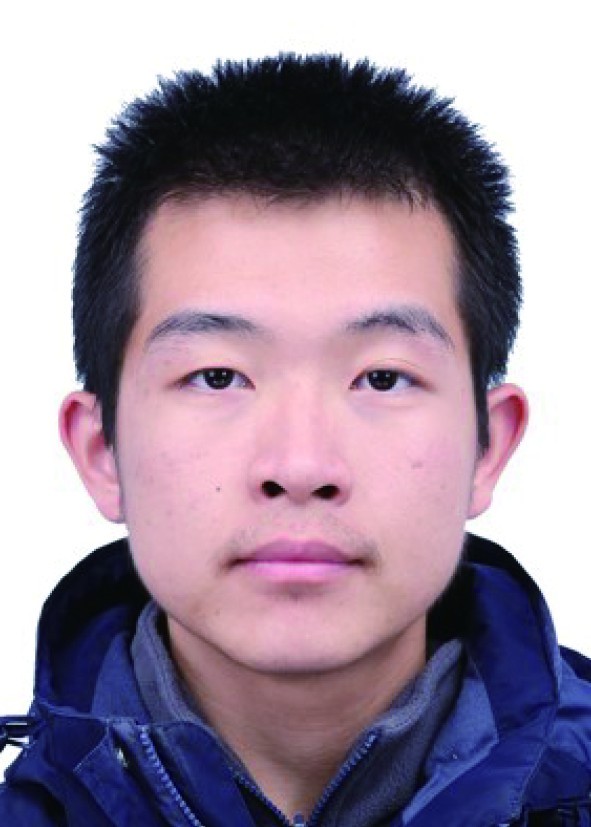| Citation: |
Zhenyao Li, Haonan Chang, Jia-Min Lai, Feilong Song, Qifeng Yao, Hanqing Liu, Haiqiao Ni, Zhichuan Niu, Jun Zhang. Terahertz phononic crystal in plasmonic nanocavity[J]. Journal of Semiconductors, 2023, 44(8): 082901. doi: 10.1088/1674-4926/44/8/082901
****
Z Y Li, H N Chang, J - M Lai, F L Song, Q F Yao, H Q Liu, H Q Ni, Z C Niu, J Zhang. Terahertz phononic crystal in plasmonic nanocavity[J]. J. Semicond, 2023, 44(8): 082901. doi: 10.1088/1674-4926/44/8/082901
|
Terahertz phononic crystal in plasmonic nanocavity
DOI: 10.1088/1674-4926/44/8/082901
More Information
-
Abstract
Interaction between photons and phonons in cavity optomechanical systems provides a new toolbox for quantum information technologies. A GaAs/AlAs pillar multi-optical mode microcavity optomechanical structure can obtain phonons with ultra-high frequency (~THz). However, the optical field cannot be effectively restricted when the diameter of the GaAs/AlAs pillar microcavity decreases below the diffraction limit of light. Here, we design a system that combines Ag nanocavity with GaAs/AlAs phononic superlattices, where phonons with the frequency of 4.2 THz can be confined in a pillar with ~4 nm diameter. The Qc/V reaches 0.22 nm−3, which is ~80 times that of the photonic crystal (PhC) nanobeam and ~100 times that of the hybrid point-defect PhC bowtie plasmonic nanocavity, where Qc is optical quality factor and V is mode volume. The optomechanical single-photon coupling strength can reach 12 MHz, which is an order of magnitude larger than that of the PhC nanobeam. In addition, the mechanical zero-point fluctuation amplitude is 85 fm and the efficient mass is 0.27 zg, which is much smaller than the PhC nanobeam. The phononic superlattice-Ag nanocavity optomechanical devices hold great potential for applications in the field of integrated quantum optomechanics, quantum information, and terahertz-light transducer.-
Keywords:
- Optomechanics,
- phononic crystal,
- Ag plasmonic nanocavity,
- confinement,
- coupling
-
References
[1] Aspelmeyer M, Kippenberg T J, Marquardt F. Cavity optomechanics. Rev Mod Phys, 2014, 86, 1391 doi: 10.1103/RevModPhys.86.1391[2] Abbott B P, Abbott R, Abbott T D, et al. Observation of gravitational waves from a binary black hole merger. Phys Rev Lett, 2016, 116, 061102 doi: 10.1103/PhysRevLett.116.061102[3] Wallucks A, Marinković I, Hensen B, et al. A quantum memory at telecom wavelengths. Nat Phys, 2020, 16, 772 doi: 10.1038/s41567-020-0891-z[4] Kuruma K, Pingault B, Chia C, et al. Coupling of a single tin-vacancy center to a photonic crystal cavity in diamond. Appl Phys Lett, 2021, 118, 230601 doi: 10.1063/5.0051675[5] Barzanjeh S, Xuereb A, Gröblacher S, et al. Optomechanics for quantum technologies. Nat Phys, 2022, 18, 15 doi: 10.1038/s41567-021-01402-0[6] Zhou Z Q, Cui Y, Tan P H, et al. Optical and electrical properties of two-dimensional anisotropic materials. J Semicond, 2019, 40, 061001 doi: 10.1088/1674-4926/40/6/061001[7] Chang H N, Li Z Y, Lou W K, et al. Terahertz cavity optomechanics using a topological nanophononic superlattice. Nanoscale, 2022, 14, 13046 doi: 10.1039/D2NR03376C[8] Meenehan S M. Cavity optomechanics at Millikelvin temperatures. PhD Dissertation, California Institute of Technology, 2015 (in USA)[9] Zhang H Y, Liu Y C, Wang C Y, et al. Hybrid photonic-plasmonic nano-cavity with ultra-high Q/V. Opt Lett, 2020, 45, 4794 doi: 10.1364/OL.402781[10] Benz F, Schmidt M K, Dreismann A, et al. Single-molecule optomechanics in picocavities. Science, 2016, 354, 726 doi: 10.1126/science.aah5243[11] Su R, Ghosh S, Wang J, et al. Observation of exciton polariton condensation in a perovskite lattice at room temperature. Nat Phys, 2020, 16, 301 doi: 10.1038/s41567-019-0764-5[12] Spillane S M, Kippenberg T J, Vahala K J. Ultralow-threshold Raman laser using a spherical dielectric microcavity. Nature, 2002, 415, 621 doi: 10.1038/415621a[13] Armani D K, Kippenberg T J, Spillane S M, et al. Ultra-high-Q toroid microcavity on a chip. Nature, 2003, 421, 925 doi: 10.1038/nature01371[14] Zhang H Y, Zhao W, Liu Y T, et al. Photonic-plasmonic hybrid microcavities: Physics and applications. Chin Phys B, 2021, 30, 117801 doi: 10.1088/1674-1056/ac0db3[15] Esmann M, Lamberti F R, Senellart P, et al. Topological nanophononic states by band inversion. Phys Rev B, 2018, 97, 155422 doi: 10.1103/PhysRevB.97.155422[16] Chan J, Alegre T P, Safavi-Naeini A H, et al. Laser cooling of a nanomechanical oscillator into its quantum ground state. Nature, 2011, 478, 89 doi: 10.1038/nature10461[17] Chan J, Safavi-Naeini A H, Hill J T, et al. Optimized optomechanical crystal cavity with acoustic radiation shield. Appl Phys Lett, 2012, 101, 081115 doi: 10.1063/1.4747726[18] MacCabe G S, Ren H J, Luo J, et al. Nano-acoustic resonator with ultralong phonon lifetime. Science, 2020, 370, 840 doi: 10.1126/science.abc7312[19] Norte R A, Moura J P, Gröblacher S. Mechanical resonators for quantum optomechanics experiments at room temperature. Phys Rev Lett, 2016, 116, 147202 doi: 10.1103/PhysRevLett.116.147202[20] Vahala K J. Optical microcavities. Nature, 2003, 424, 839 doi: 10.1038/nature01939[21] Asano T, Noda S. Optimization of photonic crystal nanocavities based on deep learning. Opt Express, 2018, 26, 32704 doi: 10.1364/OE.26.032704[22] Yamamoto T, Pashkin Y A, Astafiev O, et al. Demonstration of conditional gate operation using superconducting charge qubits. Nature, 2003, 425, 941 doi: 10.1038/nature02015[23] Li Q, Wang S S, Chen Y T, et al. Experimental demonstration of plasmon propagation, coupling, and splitting in silver nanowire at 1550-nm wavelength. IEEE J Sel Top Quantum Electron, 2011, 17, 1107 doi: 10.1109/JSTQE.2010.2070061[24] Ji Y N, Fang G Q, Shang J Y, et al. Aligned plasmonic antenna and upconversion nanoparticles toward polarization-sensitive narrowband photodetection and imaging at 1550 nm. ACS Appl Mater Interfaces, 2022, 14, 50045 doi: 10.1021/acsami.2c14127[25] Kim M, Jeong C Y, Heo H, et al. Optical reflection modulation using surface plasmon resonance in a graphene-embedded hybrid plasmonic waveguide at an optical communication wavelength. Opt Lett, 2015, 40, 871 doi: 10.1364/OL.40.000871[26] Edahiro T, Horiguchi M, Chida K, et al. Spectral loss characteristics of GeO2-P2O5-doped silica graded-index fibres in long-wavelength band. Electron Lett, 1979, 15, 274 doi: 10.1049/el:19790194[27] Henschel H, Koehn O, Schmidt H U. Radiation-induced loss of optical fibers at 1300-nm and 1550-nm wavelength. Journal, 1996, 68, 2811 doi: doi.org/10.1117/12.254026[28] Mueller T, Xia F N, Avouris P. Graphene photodetectors for high-speed optical communications. Nat Photonics, 2010, 4, 297 doi: 10.1038/nphoton.2010.40[29] Barnes W L, Dereux A, Ebbesen T W. Surface plasmon subwavelength optics. Nature, 2003, 424, 824 doi: 10.1038/nature01937[30] Holsteen A L, Raza S, Fan P Y, et al. Purcell effect for active tuning of light scattering from semiconductor optical antennas. Science, 2017, 358, 1407 doi: 10.1126/science.aao5371[31] Li Y Z, Cui K Y, Feng X, et al. Optomechanical crystal nanobeam cavity with high optomechanical coupling rate. J Opt, 2015, 17, 045001 doi: 10.1088/2040-8978/17/4/045001[32] Biegelsen D K. Photoelastic tensor of silicon and the volume dependence of the average gap. Phys Rev Lett, 1974, 32, 1196 doi: 10.1103/PhysRevLett.32.1196[33] Lide D R, Bruno T J. CRC handbook of chemistry and physics. Cleveland, Ohio: CRC Press, 2012[34] Baker C. On-chip nano-optomechanical whispering gallery resonators. PhD Dissertation, Université Paris, 2013 (in French)[35] Chen C L. Foundations for Guided-Wave Optics. Hoboken: Wiley, 2005[36] Lamberti F R, Yao Q, Lanco L, et al. Optomechanical properties of GaAs/AlAs micropillar resonators operating in the 18 GHz range. Opt Express, 2017, 25, 24437 doi: 10.1364/OE.25.024437 -
Proportional views






 DownLoad:
DownLoad:













 Zhenyao Li:is now a M.S. student and is supervised by Prof. Jun Zhang at the State Key Laboratory of Superlattices and Microstructures, Institute of Semiconductors, Chinese Academy of Sciences. He received his Bachelor's degree from Nankai University in China. His current research interest focuses on quantum optomechanics
Zhenyao Li:is now a M.S. student and is supervised by Prof. Jun Zhang at the State Key Laboratory of Superlattices and Microstructures, Institute of Semiconductors, Chinese Academy of Sciences. He received his Bachelor's degree from Nankai University in China. His current research interest focuses on quantum optomechanics Jun Zhang:received his Bachelor's degree from Inner Mongolia University in China in 2004, and he received his Ph.D. from the Institute of Semiconductors, Chinese Academy of Sciences in 2010. He then worked as a postdoctoral fellow at Nanyang Technological University in Singapore from 2010 to 2015 and joined the State Key Laboratory of Superlattice for Semiconductors (CAS) as a professor in 2015. His current research focuses on light-matter interactions in semiconductor materials, including Raman and Brillouin scattering, and laser cooling in semiconductors
Jun Zhang:received his Bachelor's degree from Inner Mongolia University in China in 2004, and he received his Ph.D. from the Institute of Semiconductors, Chinese Academy of Sciences in 2010. He then worked as a postdoctoral fellow at Nanyang Technological University in Singapore from 2010 to 2015 and joined the State Key Laboratory of Superlattice for Semiconductors (CAS) as a professor in 2015. His current research focuses on light-matter interactions in semiconductor materials, including Raman and Brillouin scattering, and laser cooling in semiconductors



